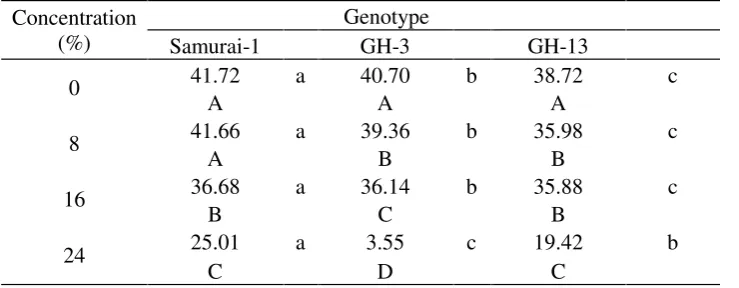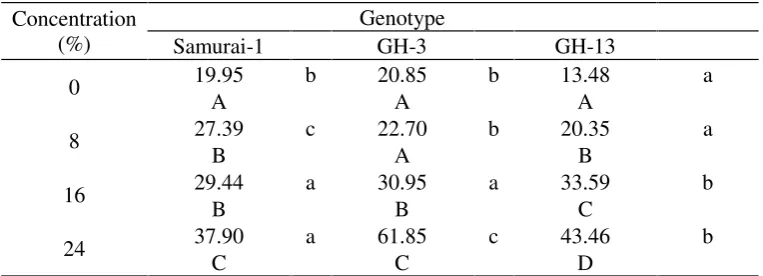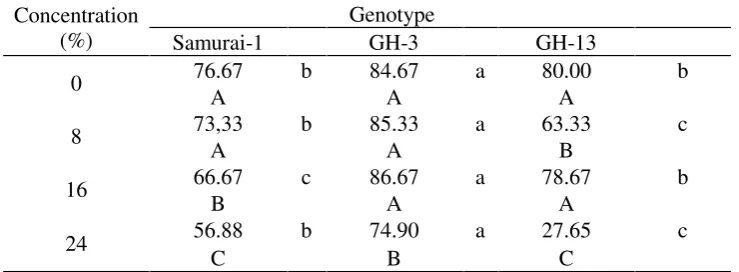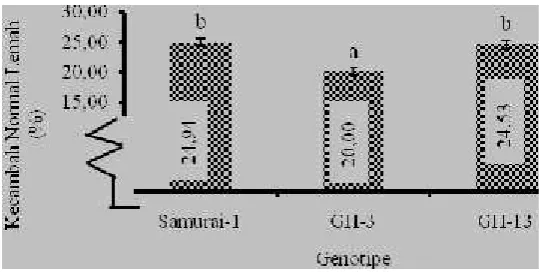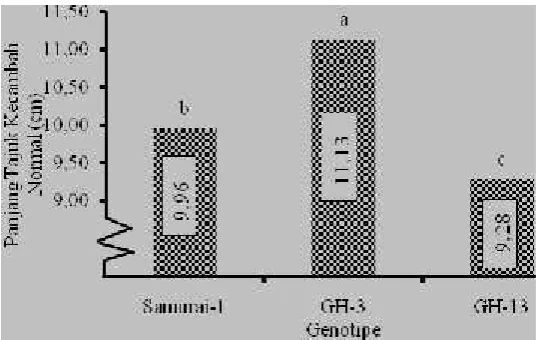Seed Viability of Three Sorghum Genotypes
(Sorghum bicolor
[L.] Moench)
in Line with Rapid Ageing Intensity Treatments of Ethanol Concentration
,
Eko Pramono¹*, Yayuk Nurmiaty¹, Kukuh Setiawan¹, and Tri Lestari²
1)
Student Department of Agronomy, Faculty of Agriculture, University of Lampung
2)
Department of Agrotechnology Faculty of Agriculture, University of Lampung 35145 Bandar Lampung, Indonesia.
*: pramono.e61@gmail.com
ABSTRACT
Efforts to develop sorghum can be done by providing seeds that have high shelf vigor. High vapor sucking seeds have high viability after long stays. To know the vigor of seed saving ability quickly can be done by viability testing after the seeds are treated with rapid chemical fastening using ethanol solution. This study aims to determine the three genotypes of sorghum seed viability,that is Samurai-1, GH-3, and GH-13 after expulsedrapidly with increasing ethanol concentrations (0,8,16 and 24%). This research was conducted at Seed Laboratory and Plant Breeding Faculty of University of Lampung from December 2016 until January 2017. The 2 factor treatment was arranged factorially (4x3) in a Perfect Scrambled Group Design with three replications. The experimental results showed that rapid irritation using ethanol concentrations up to 24% significantly reduced the viability of sorghum seeds as indicated by the total normal sprout variables, normal strong sprouts, normal dry weight of sprouts, and electrical conductivity. The interaction between ethanol and genotype concentrations is indicated by variable velocity of germination and dead seeds. The rapid relief of sorghum seed regrowth is more rapid in GH-3 genotypes than in the Samurai-1 and GH-13 genotypes.
Keyword: sorghum seed, fast expulsioninteractions, genotype.
INTRODUCTION
Indonesia is a country with a high population. The Central Bureau of Statistics (2010) reported that Indonesia's population growth rate increased by 1.48% each year since 2000. Indonesian people generally consume food in the form of rice because it contains carbohydrates. However, the availability of rice food is relatively low while human consumption is increasing (Sirappa, 2003). This shows that national food security is very risky if only rely on rice food. Therefore it is necessary to provide alternative food to overcome the problem, one of them is sorghum. Sorghum including cereal plants that have nutritional content equivalent to rice (rice) so that potential as alternative food (Sirappa, 2003). Sorghum has nutritional content of 332 cal / 100 g calories, carbohydrates 73 g / 100 g, and protein 11 g / 100 g. Sorghum can be consumed in various forms of processed products, including rice, bread, noodles, cookies, cake, and a variety of snack foods(snack).The wide variety of uses of sorghum as food and industry indicates the magnitude of market opportunities for sorghum yields.
than 20 ° C, plant growth will be hampered. During plant growth, the required rainfall ranges from 375 - 425 mm (Laimeheriwa, 1990).
Development of sorghum as a producer of food and bioethanol still encounters some obstacles, especially when done on a large scale. One of the obstacles faced is the low da ya save the seeds after harvest (Pabendon et al., 2013). Seed saving capacity is the ability of seed to be stored for a certain period. During storage, the seeds will regress naturally. Setbacks seed is a process that happens gradually and is an irreversible process(irreversible)(Sadjad et al., 1999).
According Sutopo (2012) seed saving power is influenced by genetic factors, save environment, and physical condition and physiological seed. Genetic factors are innate factors associated with seed composition. Seeds with different genotypes or varieties will have different storability. Differences in varieties also influence the rapidly decreased viability response of seeds. This is due to differences in the identity and genetic composition possessed by each variety. Justice and Bass (2002) cited by Zanzibar (2007) on suboptimum conditions, the degree of deterioration of the seeds closely related to the chemical composition of the seeds, especially fat and protein.Seed-fat and high protein will m engalami early setback. However, as the development of science and technology, there is a method of estimating seed saving ability that can provide information related to the rapid shelf life of seeds.
Rapid expulsion method (MPC) is a method of estimating seed saving by placing seeds in suboptimum condition in some concentration and certain period of time. Under these conditions, the seed will experience an accelerated setback that has characteristics similar to the natural decline of seeds. One of the fastest methods of disinfectment that can be done is chemically using an ethanol solution (Sadjad, 1994). Rendering using ethanol leads to devigoration due to the ingress of vapors or alcohols into the seed. The interaction between ethanol concentrations and the duration of horsing can decrease seed viabailitas. Decreased viability is one of the indicators of the decline of a seed. The decline of seeds occurs because ethanol can cause damage, namely the disintegration of the membrane. As a result, the enzymatic activity decreases so that it affects the metabolism (Pian, 1981). According Sadjad et al., (1999) chemical MPC MPC is more effective than physical for faster implementation and fungus can not thrive. Based on Belo and Suwarno (2012) MPC results with immersion in 96% ethanol is the best and easiest method to decrease the viability of rice seeds compared with ethanol vapor treatment and physical extraction methods. Therefore, to know the viability of seeds, it is necessary to study the effect of ethanol concentration on three genotypes of sorghum.
MATERIALS AND METHODS
Seeds:Sorghum Samurai genotype-1, GH-3, and GH-13 has been purely derived from sorghum planting gardens in the village Tulung Court, District Gading Rejo, District Pringsewu. Further research was conducted at Seed Laboratory and Plant Breeding Faculty of Agriculture University of Lampung with period of December 2016 until January 2017. Testing of seed viability was done by ethanol application at concentration 0, 8, 16, and 24%. Testing seed viability is done, namely:
calculated from observations of day 2 through day 5 (KNT = ΣKni/ Ti,Tiis the observationto-i, i= {2, 3,4, and 5}).
Simultaneity germination test:is done to get strong variable normal seedling, sprout length header normal, normal seedling primary root length and seedling dry weight normal. Twenty-five grain sorghum seed is placed between two layers of paper CD moist underneath plastic coated, then diglung and laid in a manner established in IPB typegerminator73-2A / B with temperature (26°C ± 0.4°C) ( ISTA, 2009). The observation of normal strong sprout, canopy length and root of normal germination were done at 4 days after germination (HSP). Criterias of strongnormal sprouts at the observation are has the primary roots, primary roots are not cracked, hipokotil not curly or curved, and have a complete primary leaves (Copeland and McDonald, 2001). Normal seedling dry weight obtained from weighing five samples of normal sprouts that have long measured the
canopy and the primary root sprouts normal in an oven at a temperature of 80°C for 3 x 24
hours.
Power conductivity test:Twenty-five seeds of sorghum seeds are placed in a 240 ml transparent plastic cup. The seeds were soaked with 50 ml of distilled water for 24 hours
and then measured with ameter ElectroconductivityinoLab WTW typeserieswith μ S.Cm
unit-1.
Data Analysis:This study uses a two factor treatments arranged in a factorial (4x3) in a randomized group design Perfect (RKTS) with 3 blocks as replicates. The first factor is the treatment of the ethanol concentration (K) consisting of 0% (K0),8%
(K1),16% (K2),and 24% (K3).The second factor is the genotype (G) consisting of Samurai
genotype 1 (G1),GH-3 (G2),and GH-13 (G3)so that there are 12 experimental unit. The
analysis used was (1) Bartlet test to see the homogeneity of the variation between treatments, (2) Tukey test to see the data aditivity, (3) Variety analysis to see the effect of treatment, and (4) Test of Honest Real Difference (BNJ) middle values between treatments. Each test using a 5% significance level.
RESULTS AND DISCUSSION
With the effects of ethanol concentration on the viability of the three genotypes of sorghum(Sorghum bicolor[L.] Moench) (Samurai-1, GH-3 and GH-13)
Table 1. Summary of analysis results of variations in the effect of ethanol concentration on
viability of sorghum seeds(Sorghum bicolor[L.] Moench) genotypes Samurai-1, GH-3 and
GH-13.
5. Length of Normal Sprout Primary Root (cm) * * *
6. Dry Sprout Normal Weight (mg) tn * *
7. Abnormal sprout (%) tn tn tn
8. Normal Weak Sprout (%) tn * tn
9. Length of Normal Sprout Header (cm) tn * tn
Information : K =concentration of ethanol
G =genotype
K x G =interaction between ethanol concentration and genotype
tn = not significant atα = 0,05
* = real at α = 0,05
Treatment of ethanol and genotype concentration had an effect on variable of germination rate, dead seed, total normal sprouts, normal strong sprouts, root length of normal root germination, and normal dry weight of sprouts. The electrical conductivity variables are significantly influenced by the ethanol concentration treatment. Treatment of ethanol concentration had no significant effect on abnormal germination variables, normal weak sprouts, normal canopy length, and normal dry weight of sprouts. The normal sprout variables are weak and the length of the normal canopy is markedly affected by the genotype difference. The genotype treatment had no significant effect on abnormal germination and electrical conductivity.
Interactions Between Ethanol Concentration and Genotypes on the Viability of Sorgum Seeds.
Variables of germination rate (Table 4), dead seed (Table 5), normal normalized sprouts (Table 6), normal normal root sprouts (Table 8), and normal dried germination weight (Table 9) significantly influenced by the recognition of ethanol concentrations and genotypes.
Table 4. Interaction between ethanol concentration and genotype on variable speed germination.
Description: The middle value in the table followed by the same letter, letter
uppercase letters for the concentration of ethanol and lower case for genotype
not different based on BNJ Test at α 5%.BNJ 5% ethanol concentration = 0.75%; for genotype = 0,51%.
The effect of genotype on each ethanol concentration is indicated by the germination velocity variable (Table 4). The percentage of genotype germination rate of Samurai-1 at ethanol concentration was 0% and 8% higher compared with ethanol concentration of 16% and 24%. GH-3 genotypes germination percentage percentage at 0% higher ethanol
rate compared with GH-3 and GH-13. At 24% ethanol concentration the GH-3 genotype had a lower percentage of germination rate compared to the GH-13 genotype.
Table 5. Interaction between ethanol concentration and genotype on seed variables die.
Concentration (%)
Genotype
Samurai-1 GH-3 GH-13
0 19.95 b 20.85 b 13.48 a
A A A
8 27.39 c 22.70 b 20.35 a
B A B
16 29.44 a 30.95 a 33.59 b
B B C
24 37.90 a 61.85 c 43.46 b
C C D
Description: The middle value in the table followed by the same letter, letter great for the concentration of ethanol and lower case for genotype
not different based on BNJ Testat α 5%.BNJ 5%
ethanol concentration = 2.24%; for genotype = 1.52%
The effect of ethanol concentration on each genotype is indicated by the variable of dead seed (Table 5). At 0% ethanol concentrations showed that the percentage of dead seed genotype GH-13 was lower than that of Samurai-1 and GH-3 genotypes. At 8% ethanol concentrations, the percentage of dead seeds of GH-13 was lower than that of the Samurai-1 and GH-13 genotypes. At 16% ethanol concentrations indicated that the genotype of
Samurai-1 and GH-3 had lower percentage of dead seeds compared with GH-13. The Samurai-1 genotype had a lower percentage of dead seeds than the GH-3 and GH-13 genotypes at a 24% ethanol concentration. The effect of genotype on each ethanol
concentration is shown by the variable of dead seed (Table 5). At 8% ethanol concentration the Samurai-1 genotype had the same percentage of dead seeds with a 16% ethanol
Table 6. Interaction between ethanol concentration and genotype on total normal sprout variables.
Concentration (%)
Genotype
Samurai-1 GH-3 GH-13
0 84.00 c 93.33 a 90.67 b
A A A
8 82.67 b 89.33 a 90.67 a
A B A
16 80.67 a 78.67 a 75.33 b
A C B
24 59.82 a 6.80 c 47.79 b
B D C
Description: The middle value in the table followed by the same letter, letter great for the concentration of ethanol and lower case for genotype
not different based on BNJ Test at α 5%.BNJ 5% ethanol concentration = 3.40%; for genotype = 2.31%.
The effect of ethanol concentration on each genotype was shown by the total normal sprouts variable (Table 6). At 0% ethanol concentrations showed that genotype GH-3 genotypes had higher total normal germination percentage than Samurai-1 and GH-13. The normal germination percentage of total genotype GH-3 and GH-13 was higher than Samurai-1 genotype at 8% ethanol concentration. At Samurai-16% ethanol concentration the normal
germination percentage of Samurai-1 and GH-3 genotypes was higher than that of GH-13. At 24% ethanol concentrations the normal germination percentage of Samurai-1 genotype was higher than that of GH-3 and GH-13. The GH-3 genotype had a normal tota normal
germination percentage compared with GH-13. The effect of genotype on each ethanol concentration is indicated by (Table 6). The Samurai-1 genotype had the same normal sprout percentage at concentrations of 0% to 16% and was higher than the 24% ethanol
Table 7. Interaction between ethanol concentration and genotype on strong normal sprout variables.
Concentration (%)
Genotype
Samurai-1 GH-3 GH-13
0 76.67 b 84.67 a 80.00 b
A A A
8 73,33 b 85.33 a 63.33 c
A A B
16 66.67 c 86.67 a 78.67 b
B A A
24 56.88 b 74.90 a 27.65 c
C B C
Description: The middle value in the table followed by the same letter, letter great for the concentration of ethanol and lower case for genotype
not different based on BNJ Test at α 5%.BNJ 5% ethanol concentration = 5.15%; for genotype = 3.50%.
The effect of ethanol concentration on each genotype was shown by the total normal sprouts variable (Table 7). The normal germination percentage of normal GH-3 genotypes was higher than Samurai-1 and GH-13 at 0% ethanol concentration. At 8% ethanol
concentrations indicated that the genotype GH-3 had a normal higher percentage of normal sproutscompared to Samurai-1 and GH-13. The percentage of strong normal sproutsgenotype GH-3 was higher than that of Samurai-1 and GH-13 at 16% ethanol concentration. GH-3 genotype had a strong normal sprouts percentagehigher thanSamurai-1 and GH-13 at a concentration of 24% etanol. The effect of genotype on each concentration of ethanol on normal strong sprouts variables (Table 7). The Samurai-1 genotype had the same strong normal sprouts percentage at 0% and 16% concentrations as well as higher than the normal strong sprouts percentage at ethanol concentrations of 16% and 24%. At a concentration of 0 to 16% ethanol the GH-3 genotype had the same stronger and higher normal sprouts
percentage compared with a normal strong sprout percentage at a 24% ethanol
Effect of Ethanol Concentration on the Viability of Sorgum Seeds.
The actual ethanol concentration causes the difference in viability of the sorghum seed shown by the electrical conductivity variables. The effect of ethanol concentration on viability of sorghum seeds is presented in Figure 7.
Figure 7. Effect of ethanol concentration on power variables electric conduction.
Description: The middle value in the image followed by the same letter is not
different according to the BNJ Test at α 5%.BNJ 5% = 0.47%.
The ethanol concentration factor in the electrical conductivity variables (Fig. 7) showed that at the treatment of 16% and 24% were not different. The electrical conductivity values at these concentrations differ from the ethanol concentrations of 0% and 8%. The value of electrical conductivity at the ethanol concentration was 0% higher than the ethanol concentration of 8%, 16%, and 24%.
The Effect of Genotypes on the Viability of Sorghum Seeds.
The actual genotypes caused differences in viability of sorghum seeds indicated by the normal weak sprout variables (Figure 8) and normal canopy length (Fig. 9).
Figure 8. Effect of genotype on normal sprout variables is weak.
Description: The middle value in the image followed by the same letter no
The results (Fig. 8) show that the real genotype causes different viability of sorghum seeds shown by the normal weak sprout variables. The percentage of normal weak sprouts of genotype GH-3 differs from the genotype of Samurai-1 and GH-13, while the Samurai-1 genotype is not different from the genotype GH-13 based on BNJ = 1.51%. The GH-3 genotype has a lower normal percentage of normal sprouts compared with the Samurai-1 and GH-13 genotypes.
Figure 9. Effect of genotype on variables of canopy length of normal sprouts.
Description: The middle value in the image followed by the same letter no
different according to the BNJ Test at α 5%.BNJ 5% = 0.36%
The results (Fig. 9) show that the real genotypes cause differences in viability of sorghum seeds as indicated by the normal canopy length variables. The normal canopy length of GH-3 genotypes is different from that of Samurai-1 and GH-13. The GH-3 genotype has a longer normal canopy of shoots compared to Samurai-1 and GH-13.
The results of the study (Table 3) showed that the effect of ethanol and genotype concentration was significantly on the variables of germination rate, dead seed, total normal sprouts, normal strong sprouts, normal root length of normal germination, and normal dry weight of sprouts. The effect of ethanol concentration significantly decreases the viability of sorghum seeds indicated by the variable electrical conductivity. The effect of genotypes significantly resulted in differences in viability of sorghum seeds indicated by the normal defective variables and the length of normal canopy grooves.
The results of this study are consistent with Ocran's (1985) study cited by Ekowahyuni et al. (2012) that soybean seeds immersed in 20% ethanol solution cause a decrease in vigor. The decrease in vigor in the seeds indicates that the seed has a low viability that will result in rapid decline of seed during storage (Sadjad, 1981). The decrease in viability of sorghum seeds is due to increased rates of respiration and seed metabolism. The higher the rate of respiration and the metabolism of seeds the decline of the seed will be more rapidly. During the respiration and metabolism of the seeds, there is a reshuffle of food reserves in the seeds such as carbohydrates, fats, and proteins into a simpler form. This process will produce water vapor, CO2, and energy as the end result of the respiratory
The results showed that the genotype GH-3 was more resistant to shrinkage than Samurai-1 and GH-13 based on vigor sprouts, whereas based on genotype GH-3 seed
genotypes it was not resistant to irritability compared to Samurai-1 and GH-13. In the normal strong sprouts variables, the normal root length of root sprouts, and normal dry weight of GH-3 genotypes were higher than that of Samurai-1 and GH-13. At variable speed of
germination showed that there was interaction between ethanol concentration and genotype at 24% ethanol concentration. At that concentration the genotype GH-3 has a percentage of germination rate of 3.55%. According to Sadjad (1993) the standard germination rate of seeds is 25-30% (medium) and more than 30% (high). This shows that the genotype GH-3 has a low velocity growth rate compared to Samurai-1 and GH-13. The speed of germination indicates the vigor of seedling strength as the rapidly germinating seed is better able to cope with suboptimal field conditions.
The percentage of low germination rate was followed by the normal total germination percentage of GH-3 genotype which was also lower than that of Samurai-1 and GH-13. At 24% ethanol concentrations showed that the genotype GH-3 had higher percentage of dead seeds compared to the Samurai-1 and GH-13 genotypes. This is due to the genotype GH-3 suspected to have a high protein content. According to the Justice and Bass
(2002)inZanzibar (2007), sorghum seed which has a high protein content will be faster
decline due to rapid pengusangan. According to Anggraeni (2013), rapid feeding using ethanol causes a decrease in the viability of seeds as concentration increases. This is caused by non-polar ethanol. Ethanol absorbed by seeds can denature the protein in
macromolecules.Proteins contained within the seeds consist of structural proteins and functional proteins. If the functional protein in the seed is damaged, then the metabolic system and energy transport will be disrupted and cause damage to structural proteins. This triggers the occurrence of membrane leakage and results in low energy received by the embryo to grow. The decrease in viability is a form of regressing a seed. The deterioration of seeds in rapid feeding is also due to increased lipid peroxidation activity in cell membrane seeds. Lipid peroxidation activity will increase with increasing rate of respiration and seed metabolism. Lipid peroxidation is a process that is complex due to the reaction of
polyunsaturated fatty acids making up the cell membrane phospholipids byReactive Oxygen
Species(ROS) and Valko Winarsi etal., (2007).
Deteriorationofseeds are generally characterized by increasing the value of electrical conductivity. The electrical conductivity value increases due to membrane seed damage so the seeds are deteriorated.Based on the research (Ouzouline et al., 2009) the growing power and viability of wheat seeds decreased rapidly and there was an increase in electrical
conductivity value after being treated with rapid agitation. The decrease in seed viability is due to the seeds of membrane degradation resulting in loss of permeability controls indicated by higher electrical conductivity values. In this study (Figure 7) shows that the value of electrical conductivity decreases with increasing concentration of ethanol. This happens
because of ethanol (CH2CH5OH) is a non-electrolyte compounds in the solution do not
break down into ions. The ethanol compound will block the water compounds and ionic compounds released from the seeds, thereby lowering the electrical conductivity values read by the device (Purba, 2006). The decreasing electrical conductivity along with the increasing concentration of ethanol on the soreness of the sorghum seeds show the seeds regress
The genotype difference was significant in causing differences in viability responses of sorghum seeds indicated by the normal weak sprout variables (Figure 8) and the normal canopy length (Fig. 9).The GH-3 genotype had a lower percentage of normal weaker sprouts and higher normal canopy lengths compared to the Samurai-1 and GH-13 genotypes. This indicates that the GH-3 genotype is more resistant to treatment with a quickexpulsionof
ethanol concentration to 24% when compared with Samurai-1 and GH-13. The difference in viability is a form of genetic influence on seed viability. According to Sutopo (2012), seed viability differences can be caused by genetic factors, environmental factors, and seed status (physical and physiological condition of seeds). Each variety has a different genetic identity, so it will have different growth responses. Genetically every variety affects the viability of each variety. Differences of these varieties lead to differences in seed germination (Ridha et al., 2014).
The vigor parameters of sprouts and seed vigor each have interrelations. The linkage is shown by the correlation between variables. According to Young (Asriyanti and Djufry, 2013) the value of correlation coefficient 0.7-1.0 both positive and negative, showed a high degree of relationship. Coefficient correlation coefficient 0,4-0,7 both positive and negative showed degree of substantial relationship, and value of correlation coefficient 0,2-0,4 both positive and negative, showing degree of low relation. The results showed that genotype GH-3 had lower seed vigor compared with Samurai-1 and GH-13 genotypes. This is
supported by correlation between dead seed variable and germination velocity variable with r = -0.92 **. The correlation indicates that the lower the percentage of germination rate, the higher the percentage of dead seed. In addition, the correlation between the variable speed of germination and the total normal sprout with the value of r = 0.95 ** shows that the higher percentage of germination rate, the higher the percentage of total normal sprouts.
This research is in accordance with the research conducted Purnamasari et al. (2015) that the rapid feeding by using 8% ethanol causes food reserves in every seed has begun to decline. This happens because the ethanol content that enters the seeds increases, causing the seeds to denature the membrane proteins that cause increased permeability of the seed shell. This causes an increase in the percentage of dead seeds. Based on the research, it was found that genotype GH-3 had lower viability than Samurai-1 and GH-13 genotypes on fast exposure with 24% ethanol concentration. The GH-3 genotype declines faster during
storage. This is supported by the correlation between germination rate and dead seed on GH-3 genotype. The higher the percentage of dead seeds the lower the percentage of germination rate.
Conclusion
Based on research that has been done, it can be concluded that the expulsion with up to 24% ethanol concentration is evident in lowering the sorghum seed viability. Genotipe GH-3 has a lower viability when compared with Samurai genotype-1 and GH-13 by vigor shown by the variable speed of germination, dead seed, and total normal sprouts. Vaccination with a 16% ethanol concentration indicates that GH-3 has a higher vigor compared to
Samurai-1 and GH-13, but at a concentration of 24% vigor GH-3 ethanol is lower than that of Samurai-1 and GH-13 as indicated by the variable germination rate, percentage of dead seed, and percentage of normal total sprouts.
In this study showed that ethanol is nonelectrolyte so that the seeds that absorb the ethanol solution cause the ions out of the seed is not readable by the electrical conductivity measure. Therefore, for further research, it is advisable to wash seeds before the measurement of electrical conductivity nickels is performed.
BIBLIOGRAPHY
Anggraeni, ND and Suwarno, FC. 2013. Stability of Soybean Flour (Glycine max L.) after aging treatment accelerated with ethanol.Agrohorti Journal1 (4): 34 - 44.
Belo, MS and FC Suwarno. 2012. Decr reduces the viability of rice seed (Oryza sativa L.)
with some rapid aging methods.Agronomy Journal.40 (1): 29-35.Central Bureau of
Statistics. 2010. Statistics Indonesia. Jakarta.
Copeland, LO and MB McDonald. 2001. Seed Science and Technology Principle - Fourth Edition. Burgess Publishing Company. Minneapolis. Minnesota. 488 p.
Ekowahyuni, L., H. Sujono., S. Sujiprihati, M. Suhartanto, and M. Gratitude. 2012. Accelerated aging method for heat pepper strength test (Capsicum annuum L.).
Agronomy Journal. 40 (2): 132-138.
Koes, F and Arif, R. 2013. Postharvest handling of sorghum to have seeds. Proceedings of the 34th World Food Day National Seminar: Local Potential Food-Based Bioindustry 196.
Laimeheriwa, J. 1990. Technology of Sorghum Cultivation.Irian Jaya Agricultural Information Center.Jayapura.
Pabendon, MB, SB Santoso., And N. Agrosubekti. 2013. Prospect of sweet sorghum as
bioethanol raw material.J. Food Crops Research31 (1): 60-69.
Pian, ZA 1981. The Effect Of Ethyl Alcohol Steam On The Viability Of Corn Seeds (Zea mays L.) And Its Utilization To Expect The Power Of Save. And the Faculty of Post Graduate IPB. Bogor.
Purba, Michael. 2006. CHEMICALS. Erland Jakarta.
Purnamasari, L., E. Pramono, and M. Kamal. 2015. Effect of number per hole on vigor plant seeds of three varieties of sorghum (Sorghum bicolor [L] Mango) with Rapid
Appealing Method (MPC)Journal of Applied Agricultural Research15 (2): 107-114.
Ridha, R., E. Zuhry, and Nurbaiti. 2014. He applied various doses of urea to produce and
seed quality in several varieties of sorghum (S orghum bicolor L.).Journal of
Agriculture.1 (2): 1-9.
Sadjad, S. 1981. The role of seeds in the development of palawija business.Agronomy
Journal.12 (1): 12-15.
Sadjad S., 1994. Quantification of Seed Metabolism.Grasindo. Jakarta.
Sirappa, MP 2003. Prospects of sorghum development in Indonesia as an alternative
commodity for food, feed, and industry.Agricultural R & D journal. 22 (4): 133-140. Sutopo, L. 2012. Seed Technology.(Revised 8th).PT. Raja GrafindoPersada. Jakarta. 238. Tatipata, A., P. Yudono, A. Purwantoro, and W. Mangoendidjojo. 2004. Study of Physiology
and Biochemical Aspects of Detergent of Soybean Seeds in Storage. Agricultural science 11 (2): 76-87.
Zanzibar, M. 2007. Effect of aging with ethanol vapor on the physiological quality of acacia seeds (Acacia auriculiformis), Merbau (Intsiabijuga) and Mindi (Meliaazedarach).
![Table 1. Summary of analysis results of variations in the effect of ethanol concentration onviability of sorghum seeds (Sorghum bicolor [L.] Moench) genotypes Samurai-1, GH-3 andGH-13.](https://thumb-ap.123doks.com/thumbv2/123dok/3984117.1927537/3.595.76.457.556.734/summary-analysis-variations-concentration-onviability-sorghum-genotypes-samurai.webp)
